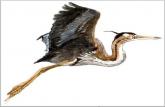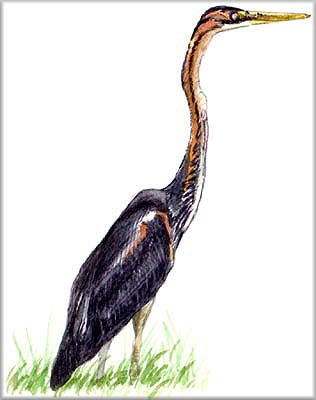Purple Heron - Ardea purpurea
Distinguished from the other large herons by its dark plumage and more "snaky" shape. Its more developed and protruding legs and feet can be seen in flight.
Because of it tawny-chestnut coloured neck, streaked longitudinally with black on the white forepart, this species mimics the thick marshland vegetation. Indeed, the Purple Heron occupies quite a different ecological niche from the other herons, frequenting reed and cane thickets rich in emergent wetland plants.
This adaptation prevents the species from competing directly with the more robust Grey Heron whilst at the same time it can share the same habitat and same feeding specialisations.
The Purple Heron cannot tolerate human disturbance and is less gregarious than other herons, although it usually does nest in colonies. In the majority of cases it builds small mono-specific heronries within extensive reed or cane beds.
A long-distance nocturnal migratory bird, it spends winter in tropical Africa reaching as far as the extreme south and Madagascar.
Because of the drastic fall in suitable habitats, the Purple Heron has been through a long phase of decline and has only started to re-establish its numbers in recent years: it is included in the Red List of Nesting Birds in Italy.
Thanks to the conservation of large, undisturbed reed and cane thickets within the Nature Reserves set up by the Province of Pistoia, the Purple heron has recently become one of the nesting species at the Fucecchio Marshes.





